nazis
If you’re the type of person who discusses politics online, you’re likely to have heard of Godwin’s law. In 1990, Mike Godwin, a First Amendment lawyer, invented this rule to address a common occurrence: The longer online debate drags on, the more likely someone commits the fallacy of reductio ad Hitlerum — i.e., the comparison of someone or something to Adolf Hitler or the Nazis.
Invoking Nazis, as Godwin suggests, is a lazy way of ending a debate. I also think it’s usually motivated by a shallow understanding of history and an insensitivity toward Holocaust victims.
But there’s gotta be times when referencing the Nazis is warranted, right? I’ve been thinking about this a lot lately as U.S. politics continues down the path of polarization and a segment of Christians unabashedly preach a message of domination. We need a sharper critique of Christian nationalism and the Republican presidential candidate Donald J. Trump that’s deeper than simply labeling the former group as “Nazis” and the latter individual “Hitler.” But where do we begin?
JEWISH NEW TESTAMENT scholar Amy-Jill Levine claims that all religions are a little bit supersessionist. Christian supersessionism — which understands God’s covenant with Christians to nullify God’s covenant with the people of Israel — has been so mainstream throughout most of Christian history that it has hardly required articulating. It was just the anti-Jewish water in which we swam. Following the Holocaust, however, Christians recognized how much we’d weaponized supersessionism into antisemitism, which provided support for Nazi and white supremacist ideologies and perpetuated anti-Jewish violence. Unfortunately, Levine argues, no exegetical maneuver can fully expunge supersessionism from the New Testament — though many have tried. It’s there. And the authority of God’s word in Christian lives keeps its dangerous power ever-present.
Still, Paul’s letter to the church in Rome (which we read this month) contains Paul’s own grappling with these questions. Chapters 9 to 11 — wherein Paul corrects some of the Gentile converts who think God has now rejected the covenant with Israel — comprise the hook on which most contemporary attempts to dismantle supersessionism hang their hat. So, we’ll pay special attention to these.
This isn’t going to be an easy fix — particularly for Christians (like me!) who want to hold fast to the gospel, atone for complicity with antisemitism, and stand in solidarity with Palestinians under occupation. Still, I trust God’s promises: I believe both that God’s covenant with Israel endures and that Jesus is the Messiah. So, this month, we are going to sit with the discomfort of failing while attempting the impossible. Because, in trying, we might find a new way through.
About 1,000 protesters gathered a few blocks from a white nationalist rally Sunday, far outnumbering the fewer than two dozen Unite the Right activists who walked to Lafayette Park near the White House one year after the deadly riots in Charlottesville, Va.

Clergy protest the white supremacist rally Aug. 12. in Charlottesville, Va.. Photo by Heather Wilson (@aNomadPhotog) / Dust & Light Photo.
On Friday, I traveled to Charlottesville, Va., to bear witness. What I saw there deeply unsettled me. White supremacists, gathered for a rally at a statue of Confederate General Robert E. Lee, boldly manifested the evil legacy of America’s original sin. Unfolding in streets throughout the city the heritage of whiteness was revealed in full display. Perhaps most disturbing was the unashamed nature of this hate-filled display: In 2017, white supremacists wear no hoods.
At least one vehicle hit a crowd of people gathered in Charlottesville, Va., on Saturday, hours after police broke up a clash between white nationalists and counter-protesters, according to witnesses.
In one weekend, the swastika appeared in public places in three U.S. cities — Houston, Chicago, and New York. The sight was so offensive, average New Yorkers pulled out hand sanitizer and tissues to wipe the graffiti from the walls of the subway where it had been scrawled.
“Within about two minutes, all the Nazi symbolism was gone,” one subway rider who was there said. He added, “Everyone kind of just did their jobs of being decent human beings.”
All was apparently going fine until Micha Brumlik, a retired Frankfurt University education professor and respected Jewish commentator, wrote last June that the popular toy was “anti-Jewish, if not even anti-Semitic.”
The problem, he said, was the inscription on the open pages of the Bible that the Playmobil Luther holds. On the left is written in German: “Books of the Old Testament. END,” while the right page says “The New Testament, translated by Doctor Martin Luther.”

Image via Minerva Studio/Shutterstock.com
The incident seems like a straightforward hate crime: Swastikas sprayed in and around the New Jersey home of an Indian-American running for Congress earlier this month.
But the vandalism is steeped in religious and ethnic irony.

Image via Maryland National Guard / flickr.com
I remember talking to my mom on my walk into work not long after the death of Freddie Gray. She had been watching the news and was wondering what my sense of things was on the ground.
“Are there protests?” she asked. “Are people upset?”
Venture capitalist Tom Perkins took a beating by his former employer for likening today’s class warfare to the Holocaust, with the mega-wealthy 1 percent as victims of “Nazi” repression.
In what The Wall Street Journal obediently termed a “Progressive Kristallnacht,” the grand old man of Silicon Valley said those who criticize wealth inequality are like Nazis pursuing “class demonization.”
The firm he founded, known as Kleiner Perkins, immediately disavowed the 82-year-old Perkins, saying, “We were shocked by his views expressed today in the WSJ and do not agree.”
NO ORDINARY MEN: Dietrich Bonhoeffer and Hans von Dohnanyi, Resisters Against Hitler in Church and State is a tightly woven story framed by the sophisticated historical analysis of its two authors, former senior Farrar, Straus, and Giroux editor Elisabeth Sifton (daughter of theologian Reinhold Niebuhr) and Columbia University professor emeritus Fritz Stern, a famed German scholar. The book profiles two brave young men—Bonhoeffer, a theologian and minister deeply involved in fighting the Nazis’ efforts to control the German Protestant churches, and Dohnanyi, a brilliant lawyer (son of Hungarian composer Ernst Dohnanyi) working in the German Ministry of Justice, who used his key position to methodically collect evidence against the Nazi regime.
Sifton and Stern portray Dohnanyi in detail as a leader in the small but high-powered German resistance movement. Brig. Gen. Hans Oster, a resistance member, hired Dohnanyi away from the Ministry of Justice ostensibly to help run the Abwehr, a German military intelligence organization that was also the center of the anti-Hitler resistance, in 1939. Dietrich Bonhoeffer was then recruited by Dohnanyi to be part of this team. Dohnanyi’s wife, Christine (Bonhoeffer’s sister), is also revealed as a significant influence on and aide to her husband.
The slim, 157-page volume is an important new historical work in the growing field of research on the German resistance movement during World War II. It is a penetrating look at Dohnanyi’s dangerous operations against the Nazis with historical perspective that other books on him and Bonhoeffer lack. Earlier biographies, written mainly by church people, more or less emphasized Bonheoffer as a singular hero fighting Hitler. Bonhoeffer was indeed very brave and traveled thousands of miles abroad while working as an agent for the Abwehr, but he was just one of a circle of resisters.
WASHINGTON — The adult survivors of the Holocaust are mostly gone now, and those who survived as children — and were old enough at the time to remember their ordeals — are now in their 70s and 80s.
It won’t be long before no eyewitnesses remain.
That’s why, as the U.S. Holocaust Memorial Museum marks its 20th anniversary today (April 29) with more than 750 survivors, museum officials are calling it one the last large gatherings of those who managed to escape Hitler’s death machine.
For those who have dedicated themselves to teaching future generations about the Holocaust and its victims, the demise of the survivors means looking backward in a different way — a way that no longer includes people looking others straight in the face and recounting what they saw and what they lived.
Gilbert and Eleanor Kraus lived a comfortable life in 1930s Philadelphia, where he made a good living as a lawyer, and she kept a stylish house.
They were secular Jews who sent their children to a Quaker school, and unlikely candidates for the mission they assigned themselves. Gilbert revealed the plan to his wife as he was shaving in the bathroom, so their young son and daughter would not hear.
He wanted to go to Vienna and save 50 Jewish children from the Nazis.
When people talk about the fall of humanity in the Jewish Genesis story, we never talk much about the Tree of Life. The Tree of the Knowledge of Good and Evil gets all the headlines and sermons because that’s the one that’s supposed to define us. That’s what we see, when we look around at humanity: The Fall, and a lot of evil triumphing over good.
Martin Luther, the father of Protestant churches, “was once asked what God was doing before the creation of the world,” according to German Lutheran theologian Dietrich Bonhoeffer. “His answer was that he was cutting canes for people who ask such useless questions.”
Who says you can’t offer a doctrine of abundant grace with a bit of sarcastic wit? For Bonhoeffer, this was really a question of why. Why did God create? What was going on, such that God decided to make a world? As Bonhoeffer saw it, this is a question rooted in guilt, shame, and fear. It’s really asking: What did God want of the world? What did God make me for? Am I living up to it? Am I accepted? It’s a question falling from the Tree of the Knowledge of Good and Evil, not the Tree of Life.
CLEVELAND--Former Ohio autoworker John Demjanjuk died Saturday (March 17) in Germany, ending nearly 35 years of legal battles with officials in three countries who claimed he was a guard in a Nazi death camp. He was 91.
During his decades-long trials, Demjanjuk was imprisoned in the United States, sentenced to death in Israel -- until its highest court freed him -- and, last May, convicted in Germany for serving as an accessory in the deaths of more than 28,000 people at a death camp.
A German court sentenced Demjanjuk to five years in prison but he was freed while he appealed the conviction.
Demjanjuk had been living in a nursing home in Bad Feilnbach in southern Germany, according to The Associated Press. He died nearly three years after being taken from his home in suburban Cleveland and flown overseas.
Demjanjuk was deported after U.S. judges ruled that he lied about his Nazi past when he entered the country in 1952 and that he was a guard at two concentration camps and a death camp in World War II.










